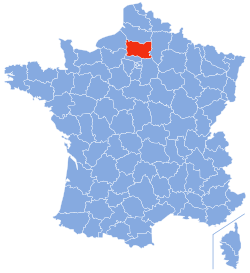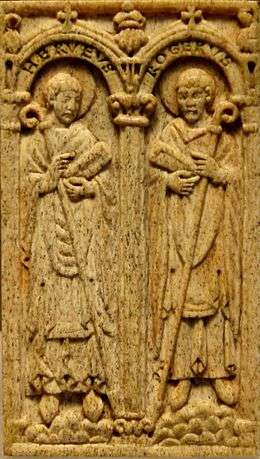Roman Catholic Diocese of Beauvais
| Diocese of Beauvais, Noyon and Senlis Dioecesis Bellovacensis, Noviomensis et Silvanectensis Diocèse de Beauvais - Noyon - Senlis | |
|---|---|
|
| |
| Location | |
| Country | France |
| Territory | Oise |
| Ecclesiastical province | Reims |
| Metropolitan | Archdiocese of Reims |
| Statistics | |
| Area | 5,855 km2 (2,261 sq mi) |
| Population - Total - Catholics |
(as of 2012) 804,100 714,000 (88.8%) |
| Parishes | 45 |
| Information | |
| Denomination | Roman Catholic |
| Rite | Latin Rite |
| Established | 3rd century |
| Cathedral | St. Peter's Cathedral, Beauvais |
| Patron saint | St. Lucian of Beauvais |
| Secular priests |
123 (diocesan) 30 (religious Orders) |
| Current leadership | |
| Pope | Francis |
| Bishop | Jacques Benoit-Gonnin, Comm. l'Emm. |
| Metropolitan Archbishop | Thierry Jordan |
| Map | |
 | |
| Website | |
| oise.catholique.fr | |
The Roman Catholic Diocese of Beauvais (Lat:Diocesis Bellovacensis) is a diocese of the Latin Rite of the Roman Catholic Church in France. The diocese encompasses the department of Oise in the Region of Picardie. The diocese is a suffragan of the Archdiocese of Reims. The current bishop is Jacques Benoit-Gonnin, appointed in 2010.
History
The diocese of Beauvais was traditionally founded by St. Lucian (Lucianus, Lucien) in the 3rd century. After 1013 the Bishops were simultaneously Counts of Beauvais, and one of the Peers of France. The Bishop had a role in the coronation ceremony of the French king, and played a role in politics; Roger II died during the First Crusade, Philip of Dreux was a participant in the Third Crusade and the Battle of Bouvines, and Pierre Cauchon was involved in the trial of Joan of Arc.
The diocese was abolished during the French Revolution, and was recreated as part of the Diocese of Amiens in 1802. Beauvais was re-established in 1822, and the Diocese of Beauvais-Noyon–Senlis was created in 1851, comprising the territories of all three formerly separate dioceses. Beauvais Cathedral serves as the seat of the new diocese.
Bishops of Beauvais
Roman and Medieval Period
- St. Lucianus (3rd century)
- Thalasius
- Victor
- Chanarus
- Numitius
- Licerius
- Themerus
- Bertegesillus
- Rodomarus
- Ansoldus
- Ribertus
- Cogerimus
- Maurinus
- Constantinus
- Himbertus
- Radingus (632-660)
- Dodon
- St. Marinus
- Rocoaldus
- Miroldus
- Clement
- St. Constantinus
- Ercambertus
- Austringus
- Deodatus
- Andreas
- Hodingus
- Adalmanus
- Ragimbertus
800–1100
- St. Hildemanus
- Erminfridus (846-859) designated in 853 as missus dominicus, in charge of inspecting the districts of Paris, Meaux, Senlis, Beauvais, Vendeuil and Vexin, died 859 in Beauvais, massacred during a new incursion of the Normans
- Odo I (860-881)
- Hrotgarius (881-888)
- Honoratus (888-890)
- Herluin (909-921)
- Bovon
- Hildegar
- Walleran (933-972)
- Harvey (987-997)
- Hugues (997-1002)
- Roger of Blois (1002–1022), Keeper of the Seals (995 - 1000) of Kings Hugh Capet and Robert the Pious, hereinafter Beauvais Bishopric elevated to title Bishop-Count
- Garin (1022–1030)
- Drogon (1035–1058)
- Guilbert (1059–1063)
- Guido (1063–1085), resigned
- Ursion of Melun (1085–1089)
- Fulk of Dammartin (1089–1095)
- Roger II (1095–1096), Keeper of the Seals, died in Egypt during the First Crusade
- Ansel (1096–1099)
1100–1300

- Galon (1099-1104), later Bishop of Paris and papal legate in Poland
- Godfrey of Pisseleu (1104-1114)
- Peter of Dammartin (1114–1133)
- Odo II (1133–1144)
- Odo III (1144–1148)
- Henry (1149–1162), later Archbishop of Reims, fourth son of King Louis VI of France
- Bartholomew of Montcornet (1162–1175)
- Philip of Dreux (1175–1217), participant of the Third Crusade and Albigensian Crusade son of Robert I of Dreux, and thus nephew of Henry (above)
- Milo of Nanteuil (1217–1234), participant in the Albigensian Crusade with King Louis VIII of France
- Godfrey of Clermont (1234–1236)
- Robert of Cressonsacq (1237–1248), dedicated the Church of Saint-Étienne de Cambronne-lès-Clermont, died in Cyprus during the Seventh Crusade)
- William of Gres (1249–1267)
- Reginald of Nanteuil (1267–1283), brother of Philippe de Nanteuil
- Theobald of Nanteuil (1283–1300), Seigneur of Nanteuil, son of Philippe de Nanteuil
Fourteenth Century
- Simon II of Clermont-Nesle (1301–1312/13), previously Bishop of Noyon son of Simon II of Clermont, Seigneur of Nesle
- Jean de Marigny (1313–1347), later Archbishop of Rouen, Lord Chancellor of France (1329), brother of Enguerrand de Marigny
- William Bertran (1347–1356), previously Bishop of Bayeux, brother of Robert VIII Bertrand de Bricquebec
- Philippe of Alençon (1356–1360), later Archbishop of Rouen, son of Charles II of Alençon
- Cardinal John of Dormans (1360–1368), previously Bishop of Lisieux, Lord Chancellor of France (1357-1371), created cardinal in 1368, resigned shortly after (died in 1373)
- John of Augerant (1368–1375), previously Bishop of Chartres
- Milo of Dormans (1375–1387), previously Bishop of Angers and previously Bishop of Bayeux, President-Clerk of the Court of Finances of Paris (1376-1380), Lord Chancellor of France (1380-1383), son of Guillaume de Dormans and nephew of Jean de Dormans (above)
- William of Vienne (1387–1388), previously Bishop of Autun, later Archbishop of Rouen
- Thomas of Estouteville (1388–1395), relative of Cardinal Guillaume d'Estouteville, brother of Bishop Guillaume d'Estouteville Ier
- Louis of Orléans (1395–1397), previously Bishop of Poitiers, son of Philip, Duke of Orléans who is the fifth son of King Philip VI of France, died in Jerusalem 1397
Fifteenth Century
- Peter of Savoisy (1398–1412), previously Bishop of Le Mans
- Bernard of Chevenon (1413–1420), previously Bishop of Amiens
- Pierre Cauchon (1420–1432), condemned St.Joan of Arc, later Bishop of Lisieux
- Jean Juvenal des Ursins[1] (1433–1444), later Bishop of Laon, later Archbishop of Reims
- Guillaume d’Hellande (1444–1462)
- Jean de Bar (1462–1488)
Sixteenth Century
- Louis de Villiers (1497–1521), the last prelate elected, hereinafter the prelates are appointed by the King of France
- Antoine Lascaris de Tende (1523–1530), previously Bishop of Riez, later Bishop of Limoges, and later again Bishop of Riez
- Charles de Villiers (1530–1535), previously Bishop of Limoges
- Cardinal Odet de Coligny de Châtillon (Administrator, 1535–1563), Cardinal (1533-1563), son of Marshal of France Gaspard I de Coligny, brother of Admiral Gaspard II de Coligny, converted to Calvinism, deprived of all his offices and benefices, and excommunicated on 31 March 1563
- Cardinal Charles de Bourbon (1569–1575), son of Charles, Duke of Vendôme, supported by the French Holy League as rightful King of France
- Nicolas Fumée (1575–1593), previously Abbot of Saint-Pierre de la Couture, chaplain to the King of France
Seventeenth Century
- René Potier (1596–1616), Grand Aumônier of Queen Anne of Austria
- Augustin Potier (1617–1650), Grand Aumônier of Queen Anne of Austria, nephew of René Potier (above)
- Nicolas Choart de Buzenval (1651–1679)[2]
- Cardinal Toussaint de Forbin-Janson (1679–1713)
Eighteenth Century
- François Honoré Antoine de Beauvilliers de Saint-Aignan (1713–1728), previously Abbot of Saint-Germer-de-Fly, resigned from throne due to supposed incompetence, later Commendatory Abbot of the Abbey of St. Victor, Marseille
- Cardinal Étienne-René Potier de Gesvres (1728–1772)
- François-Joseph de la Rochefoucauld (1772–1792), defended the rights of the First Estate at the Estates-General of 1789, arrested and imprisoned, killed by a mob along with his brother, Pierre-Louis de La Rochefoucauld-Bayers.
French Revolution
- Jean-Baptiste Massieu (1802–1805)
1823–present
- Claude-Louis de Lesquen (1823–1825), later Bishop of Rennes
- François Hyacinthe Jean Feutrier (1825–1830)
- Jean-Louis-Simon Lemercier (1832–1838)
- Pierre-Marie Cottret (1838–1841)
- Joseph-Armand Gignoux (1842–1878)
- François Edouard Hasley (1878–1880)
- Désiré-Joseph Dennel (1880–1884), later Bishop of Arras
- Joseph-Maxence Peronne (1884–1892)
- Frédéric Fuzet (1892–1900), later Archbishop of Rouen
- Marie-Jean-Célestin Douais (1900–1915)
- Eugène-Stanislas Le Senne (1915–1937), died 14th of March, 1937
- Félix Roeder (1937–1955), retired 21st of February, 1955
- Pierre-Mararie Lacointe (1955–1965), died 23rd of April, 1965
- Stéphane Émile Alfred Desmazières (1965–1978), retired 20th of September, 1978
- Jacques André Marie Jullien (1978–1984), later Coadjutor-Archbishop of Rennes, 21st of May, 1984
- Adolphe-Maria Gustave Hardy (1985–1995), retired 13th of May, 1995
- Guy Marie Alexandre Thomazeau (1995–2002), later Archbishop of Montpellier, August 28th, 2002
- Jean-Paul James (2003-2009), later Bishop of Nantes
- Jacques Benoit-Gonnin, current occupant since 18th of March, 2010
References
- ↑ Pierre Louis Péchenard (1876). Jean Juvénal des Ursins: historien de Charles VI, Évêque de Beauvais et de Laon, Archevêque-Duc de Reims : étude sur sa vie & ses œuvres (in French). Paris: E. Thorin.
- ↑ Choart de Buzenval was a supporter of Jansenism, adviser to the Grand Conseil, and Master of Requests
Bibliography
Reference works
- Gams, Pius Bonifatius (1873). Series episcoporum Ecclesiae catholicae: quotquot innotuerunt a beato Petro apostolo. Ratisbon: Typis et Sumptibus Georgii Josephi Manz. pp. 510-512. (Use with caution; obsolete)
- Eubel, Conradus (ed.) (1913). Hierarchia catholica, Tomus 1 (second ed.). Münster: Libreria Regensbergiana. (in Latin) p. 132.
- Eubel, Conradus (ed.) (1914). Hierarchia catholica, Tomus 2 (second ed.). Münster: Libreria Regensbergiana. (in Latin) p. 104.
- Eubel, Conradus (ed.); Gulik, Guilelmus (1923). Hierarchia catholica, Tomus 3 (second ed.). Münster: Libreria Regensbergiana. p. 131.
- Gauchat, Patritius (Patrice) (1935). Hierarchia catholica IV (1592-1667). Münster: Libraria Regensbergiana. Retrieved 2016-07-06. p. 113.
- Ritzler, Remigius; Sefrin, Pirminus (1952). Hierarchia catholica medii et recentis aevi V (1667-1730). Patavii: Messagero di S. Antonio. Retrieved 2016-07-06. p. 117.
- Ritzler, Remigius; Sefrin, Pirminus (1958). Hierarchia catholica medii et recentis aevi VI (1730-1799). Patavii: Messagero di S. Antonio. Retrieved 2016-07-06. p. 119.
Studies
- Delettre, André (1843). Histoire du Diocèse de Beauvais, depuis son établissement au 3me siècle jusqu'au 2 septembre 1792 (in French). Beauvais: Desjardins.
- Jean, Armand (1891). Les évêques et les archevêques de France depuis 1682 jusqu'à 1801 (in French). Paris: A. Picard. pp. 454–458.
- Pisani, Paul (1907). Répertoire biographique de l'épiscopat constitutionnel (1791-1802). (in French). Paris: A. Picard et fils.
- Sainte-Marthe, Denis de (1751). Gallia Christiana: In Provincias Ecclesiasticas Distributa... De provincia Remensi, ejusque metropoli ac suffraganeis, Suessionensi, Laudunensi, Bellovacensi, Catalaunensi ac Noviomensi ecclesiis. 9 (in Latin). Tomus nonus (IX). Paris: Typographia Regia. pp. 691–855.
External links
- Diocese of Beauvais. Official site. (French) Retrieved: 2016-09-01.
- Georges Goyau. "Beauvais." The Catholic Encyclopedia. Vol. 2. New York: Robert Appleton Company, 1907. Retrieved: 2016-09-01.
- David M. Cheney, Catholic-Hierarchy, Diocese of Beauvais-Noyon-Senlis. Retrieved: 2016-09-01.
Coordinates: 49°25′55″N 2°04′52″E / 49.432°N 2.08118°E
